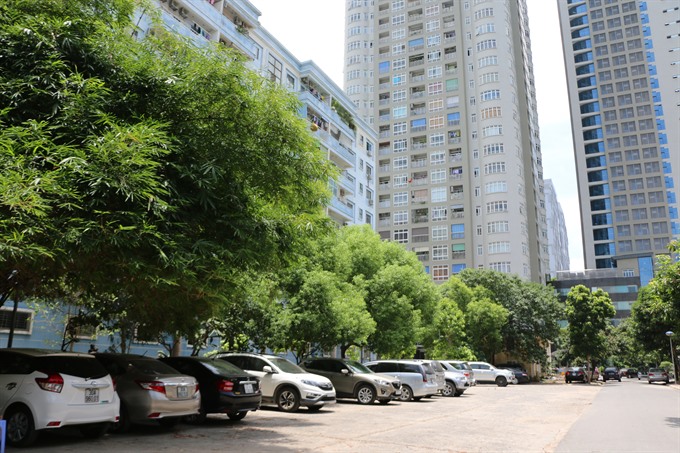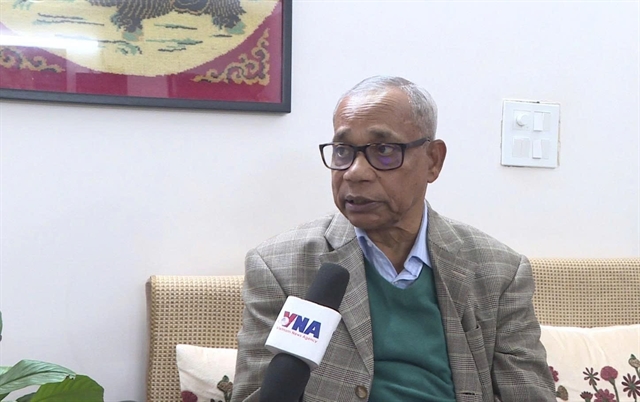 Society
Society

Big cities like Hà Nội and HCM City have few parks and playgrounds because many plots earmarked for this purpose were being used for parking, business or other projects, reported Lao Động (Labour) Newspaper.
 |
| Cars parked in a play ground of apartment buildings in Trung Hòa-Nhân Chính Urban Area in Hà Nội’s Cầu Giấy District. — VNS Photo Đoàn Tùng |
HÀ NỘI — Big cities like Hà Nội and HCM City have few parks and playgrounds because many plots earmarked for this purpose were being used for parking, business or other projects, reported Lao Động (Labour) newspaper.
The situation has caused concerns for local people, especially parents in summer time, as children have so little space for outdoor activities.
Playing spaces for children have been diminishing along with the increase in high-rise buildings.
According to the newspaper’s report, in many residential areas in Hà Nội, playgrounds and parks were being encroached by car parking lots and mobile shops.
A residential area on Linh Đàm Penisula in Hoàng Mai District, which has dozens of 40-story apartment buildings, is home to more than 30,000 people. But the collective open-air public space in the area is just a few thousands square metres.
The residents here feel hemmed in, said the paper.
In fact, there are a park and a flower garden nearby the buildings, but they were taken over and used by local businesses as parking lots, restaurants, cafes, and karaoke parlours.
Opposite Linh Đàm Park is an area of 20,000sq.m which was allocated to the Housing and Urban Development Corporation (HUD) and Hợp Phú Company for building schools and public utilities.
But the area was turned into an illegal car parking space years ago, and nothing has been done about it.
Along Lê Văn Lương Street, in Thanh Xuân District, several tall buildings have been built up in recent years.
Due to poor planning, the first floors of the buildings are shops and offices, so the sidewalks are being used for motorbike parking.
In residential areas in Nguyễn Thị Thập Street, Nguyễn Thị Định Street and Hoàng Minh Giám Street of Cầu Giấy District, recreational areas are sandwiched between apartment buildings and are frequently encroached by street vendors and car and motorbike keepers.
The recreational areas were designed to provide a space for children to play, young people to exercise and the elderly to walk and chat with their neighbours.
But now it is difficult to find such spaces full of flowers and shady trees for people doing outdoor activities.
"These public spaces and playgrounds have now been slashed, destroyed or replaced by houses, stores and food stalls, besides parking areas," Nguyễn Lan Phương, a resident said.
Likewise, tens of thousands of people living in 19 buildings in the Trung Hòa – Nhân Chính Residential Area of Thanh Xuân District now share two small gardens of just 200sq.m.
Besides this, as businesses started moving in, playgrounds in residential areas became degraded and unhygienic.
“We [parents] considered them unsafe for people, particularly children, to perform recreational activities there”, said Phương Mai, a resident.
Dr. Đào Ngọc Nghiêm, deputy president of the Việt Nam Urban Planning and Development Association said that “turning small recreation spaces in residential areas into make-shift markets or car parking lots has made the city’s appearance ugly”.
Illegally encroaching on to public spaces and playgrounds is the fault of inadequate management of buildings’ management boards and the local authorities, Nghiêm said.
To solve the problem requires the involvement of many agencies working together.
Besides, to reach the planned 3.9 sq.m of green space per capita, the city should move industrial entities, ministries and universities out of the inner city to free up land for public spaces and playgrounds for children, the architect suggested. — VNS




